LifeFone Medical Alert System
At-Home and mobile systems with lots of extra features to choose from
SafeHome.org may receive compensation from some providers listed on this page. Learn More
We may receive compensation from some providers listed on this page. Learn More
At-Home and mobile systems with lots of extra features to choose from
Formed in 1976, LifeFone is an established medical alert company. A veteran in the industry, LifeFone has kept up with technology while keeping their prices reasonable. I like that their emergency monitoring is high quality yet affordable, and that they offer unique upgrade options. These range from jewelry-inspired pendants to daily check-in phone calls for you or your loved one.
The cost for using a LifeFone medical alert system starts at $29.95 per month, and there’s no charge for equipment or activation. Couples or households with multiple medical alert users could also skip paying for two plans and just opt for one of the at-home systems. After purchasing a second help button, two people could use one system ranging from only $29.95 to $34.95 monthly. But as you might imagine, the extras can really add up. Let’s see if LifeFone is your best bet for peace of mind.
Check out more recommendations from the SafeHome team:
Thankfully, LifeFone doesn’t charge equipment or activation fees; they only charge for emergency monitoring and upgrades. You can either pay month-by-month or get a discount by paying more up front.
| LifeFone Alert System | Annual Plan | Quarterly Plan | Monthly Plan |
|---|---|---|---|
| At-Home Landline | $22.87/month | $27.95/month | $29.95/month |
| At-Home Cellular | $28.37/month | $32.95/month | $34.95/month |
| At-Home & On-The-Go | $33.87/month | $39.95/month | $39.95/month |
| At-Home & On-The-Go, VIP Active®️ | $36.62/month | $41.95/month | $43.95/month |
| At-Home & On-the-Go, VIPx® | $38.45/month | $43.95/month | $45.95/month |
Each plan is pretty risk-free, as LifeFone promises a full refund if you end up canceling within the first 30 days … and if you cancel later, they’ll apply a prorated refund. The only costs that you will need to assume are for return shipping and the cost of any accessories which cannot be returned. Overall, I think this is a reasonable return plan. These customer-friendly policies help me feel comfortable recommending the brand.
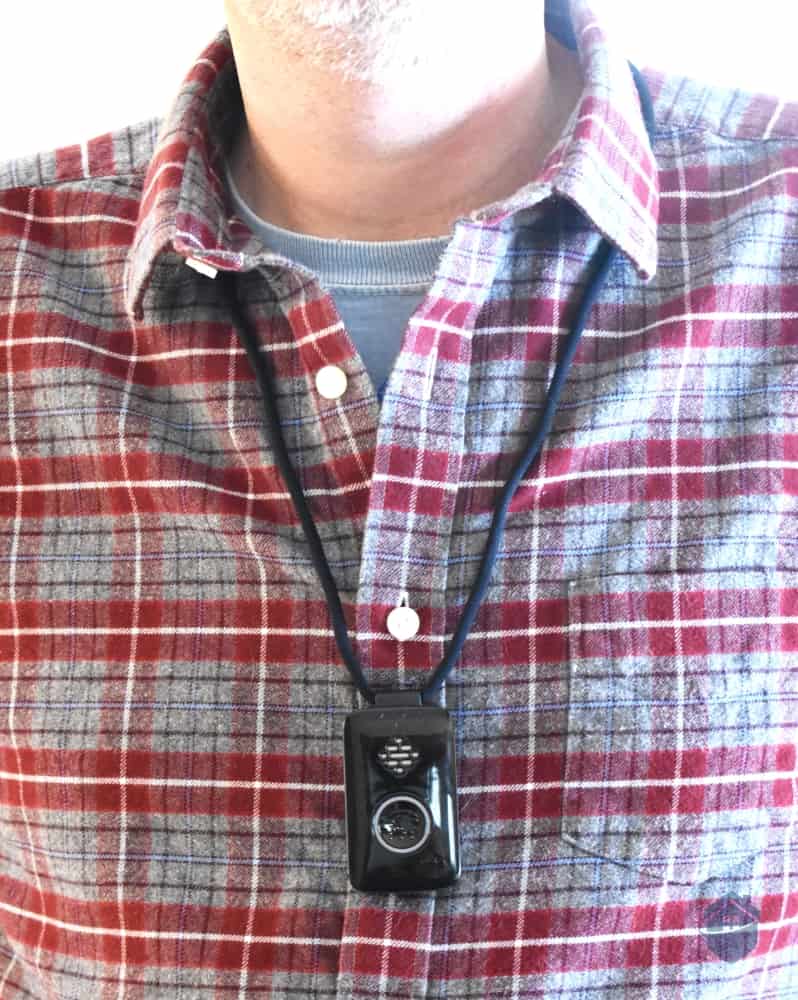
LifeFone At-Home & On-the-Go GPS Voice-In-Pendant
My favorite LifeFone accessories are the extra buttons, and they are offered at a decent price.The extra button could be used by a couple, as two people (at the same address) can share one account for $29.95 to $34.95 per month. (The system comes with only one button.) Also, similar to the Bella Charms by Bay Alarm Medical, the LifeFone vanity button is an attractive alternative to the standard wearables. Here are prices for the extra buttons and other accessories:
| LifeFone Accessory | One-Time Cost | Description |
|---|---|---|
| Additional Wearable Help Button | $39.95 |
|
| Vanity Pendant | $71.95 |
|
| Wall-Mounted Help Button | $39.95 |
|
| Wall Mount Master Lockbox | $39.95 |
|
| Hanging Master Lockbox | $39.95 |
|
| LifeFone Hanging Lockbox | $29.95 |
|
| Leather Carrying Case | $14.95 |
|
| Mobile Device Charging Cradle | $39.95 |
|
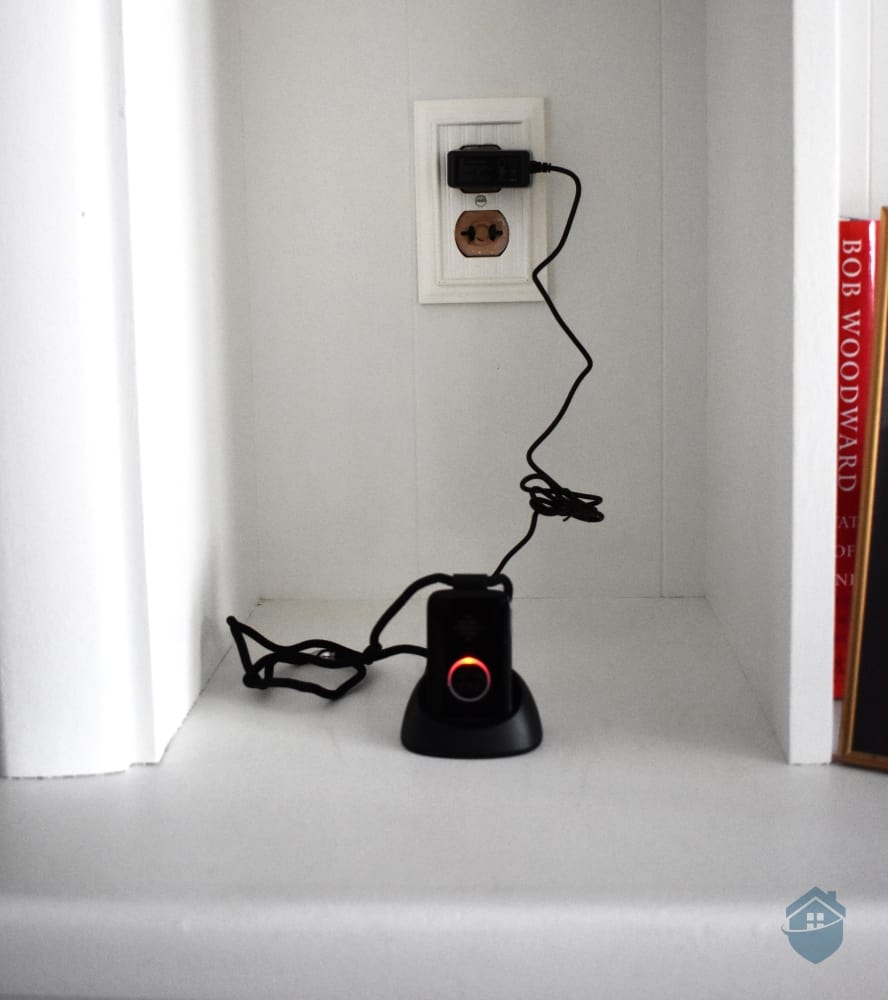
LifeFone Mobile Device Charging Cradle
Fall detection is available with four of the five LifeFone systems for just $5 per month, which is 50 percent cheaper than the industry average. (For the at-home and on-the-go GPS system, fall detection costs $10 per month.) LifeFone also offers caregiving tools and services you won’t see elsewhere. With 53 million Americans providing unpaid caregiving to another adult, caregiver assistance is vital.2
Take a look at the price chart below to better understand the service fees.
| LifeFone Add-On Service | Description | Cost | Available with All Systems? |
|---|---|---|---|
| Fall Detection | Sends an emergency signal if a fall is detected | $5 per month for most systems $10 per month for At-Home & On-the-Go |
Yes |
| Medication Reminders | An automated service that sends audio reminders to the base station | $6 per month | At-Home & On-the-Go only |
| Activity Assurance | Subscribers check in with LifeFone during a preset time daily by pressing a button on the base station | $6 per month | At-home systems only |
| Daily Check-In Call | A care agent makes a friendly daily phone call that can include customization like the time of day or a medication reminder | $19 per month | Yes |
| Location Service | Caregivers can check a subscriber’s location | $9 per month | At-Home & On-the-Go only |
| LifeFone Protection | Insurance in case equipment becomes lost, stolen, or damaged | $5 per month | Yes |
| Caregiver App | Location tracking, check on first motion of day, and more | $8 per month | At-Home & On-the-Go VIPx® only |
Like most medical alert brands these days, LifeFone sells medical alert systems for home and away. The at-home systems have up to a 1,300-ft range depending on home layout, so they allow for more space to roam compared to other top medical alert systems I’ve tested. And LifeFone’s On-the-Go systems work anywhere they can receive an AT&T cellular signal. AT&T advertises that the coverage is robust in most parts of the U.S. except Alaska.3 I found this to be accurate based on my hands-on review of LifeFone.
Those who don’t receive a strong AT&T signal may want to consider one of LifeFone’s newest products, the At-Home & On-the-Go, VIP Active®️ or At-Home & On-the-Go, VIPx®, which offer the option of using AT&T or Verizon.
FYI: LifeFone isn’t only for medical alerts.You can also push a wearable or wall button in case of fire, burglary, or other danger. Also, their emergency smartphone app can serve as a virtual security escort; use it to keep an operator on the line until you arrive someplace safe.
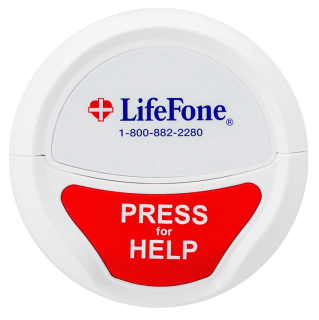
LifeFone Wall-Mounted Help Button
The At-Home Landline is LifeFone’s most affordable medical alert package. Its starting price is $29.95 per month. Fall detection can be added to this system for only $5 per month. LifeFone includes one standard wearable button for the wrist or neck. The base station can also use your home landline to send alerts from a second standard wearable, a vanity pendant, and wall-mounted buttons.
Best For: LifeFone At-Home Landline is best for seniors who don’t leave home alone.
Did You Know? In the U.S., the percentage of households that use cellphones exclusively is 55 percent. The percentage of households that use both wireless and a landline is roughly 35 percent. And the percentage that use only a landline is just over 5 percent.4
LifeFone’s At-Home Cellular system provides protection without a home landline connection, as the base station has a 4G cellular chip for signaling. The starting rate is $34.95 per month. Like the landline base station, the At-Home cellular plan can monitor buttons from up to 1,300 feet away. This works for LifeFone’s standard wearable buttons, vanity pendants, and wall-mounted panic buttons. Just one wearable is included for free, but two people can share the system. Extra buttons are sold separately as described above.
Best For: LifeFone’s At-Home cellular plan is best for seniors who don’t have a landline and don’t leave home alone.
FYI: With a LifeFone at-home system, you won’t need to recharge your standard pendant or wrist button. The battery lasts for up to five years. LifeFone monitors the charge and sends a free replacement if power drops to 20 percent.
This LifeFone plan provides coverage through AT&T’s 4G network. It includes a home base station, a mobile device, and a wearable button. Fall detection is offered through a separate pendant. The base station and the mobile device allow two-way voice communication with emergency operators; the pendant itself doesn’t have two-way talk. Service starts at $39.95 per month.
Best For: Seniors who primarily need coverage at home but do go out on their own occasionally.
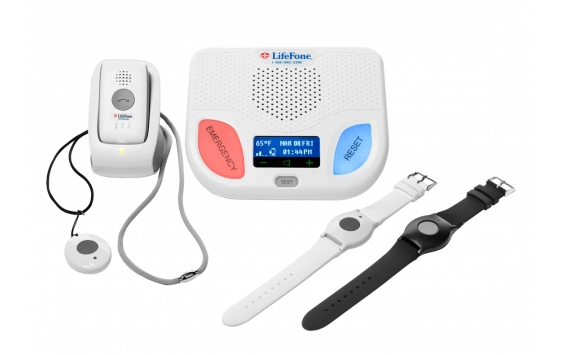
LifeFone At-Home & On-the-Go Package
This advanced GPS system has two-way voice communication and location detection built into the pendant. An all-in-one device, it can also have fall detection embedded within it. No need for a separate fall detection pendant.
For a comparison of the best systems with fall detection, read our guide, Best Medical Alert Systems with Fall Detection.
In addition, the system leads the industry with its battery life — up to 30 days. Monitoring starts at $43.95 per month. Note that the system includes a home charging unit and a belt clip.
Best For: Seniors who like to be out and about and want the most advanced technology and design available.
Pro Tip: If ordering LifeFone, you will be using LifeFone’s cellular service, not your own. You have your choice of either Verizon or AT&T service.
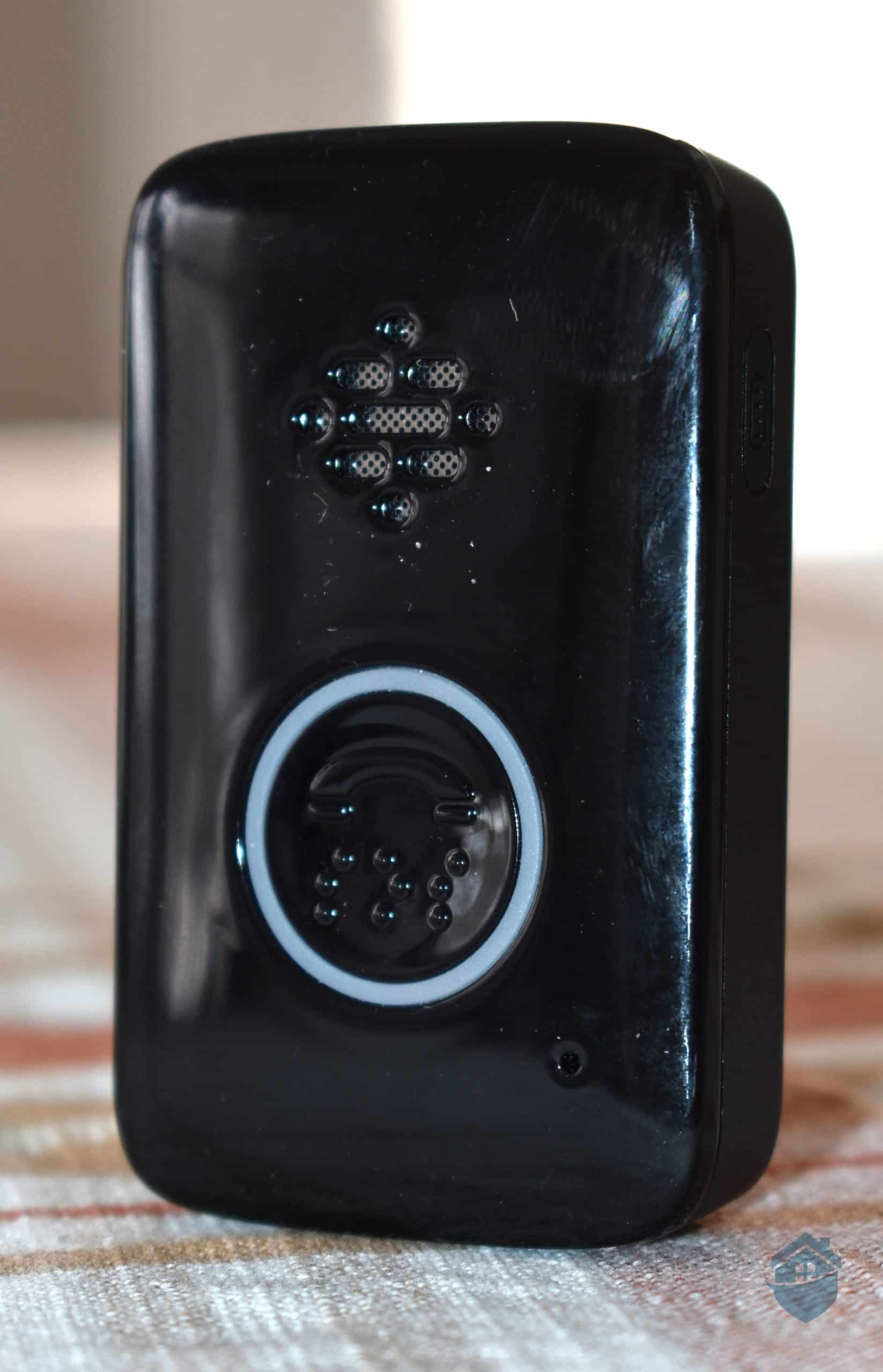
Closeup of the LifeFone Voice-In-Pendant
LifeFone’s newest addition to their lineup, the VIPx®, is a discreet device weighing only 1.3 ounces and coming in your choice of three colors 一 silver, white, and black. It boasts a battery life of up to 16 days, not as long as the VIP Active®️ but still longer than any other on-the-go device that we have seen.
This sophisticated system can connect to either AT&T or Verizon and uses advanced location tracking. In addition, the VIPx® comes with the option to add the Caregiver App which provides caregiver tracking, checks the first motion of the day, and alerts caregivers if the subscriber presses the help button. Monitoring begins at $45.95 per month.
Best For: Active seniors who want advanced technology and an inconspicuous presentation or those who require a high level of caregiver monitoring.
All LifeFone plans currently include free shipping and at least one month of free monitoring if you choose a quarterly or annual payment plan. I have found that most medical alert companies offer similar payment plans along with corresponding enticements, but I always like opportunities to save a few bucks.
LifeFone offers an additional deal that can help you save. You will get a free month of service for every new subscriber you refer. This is a nice little perk. Think about how much money a LifeFone subscriber in an elder care community could save by referring their friends!
LifeFone also provides a price-lock guarantee to all of its subscribers. This means that after you subscribe, your monthly cost will never increase. This should be reassuring to everyone on a fixed income.
FYI: Automatic fall detection can sense about 95 percent of falls. It’s an option with any LifeFone pendant worn around the neck (at-home or on-the-go).
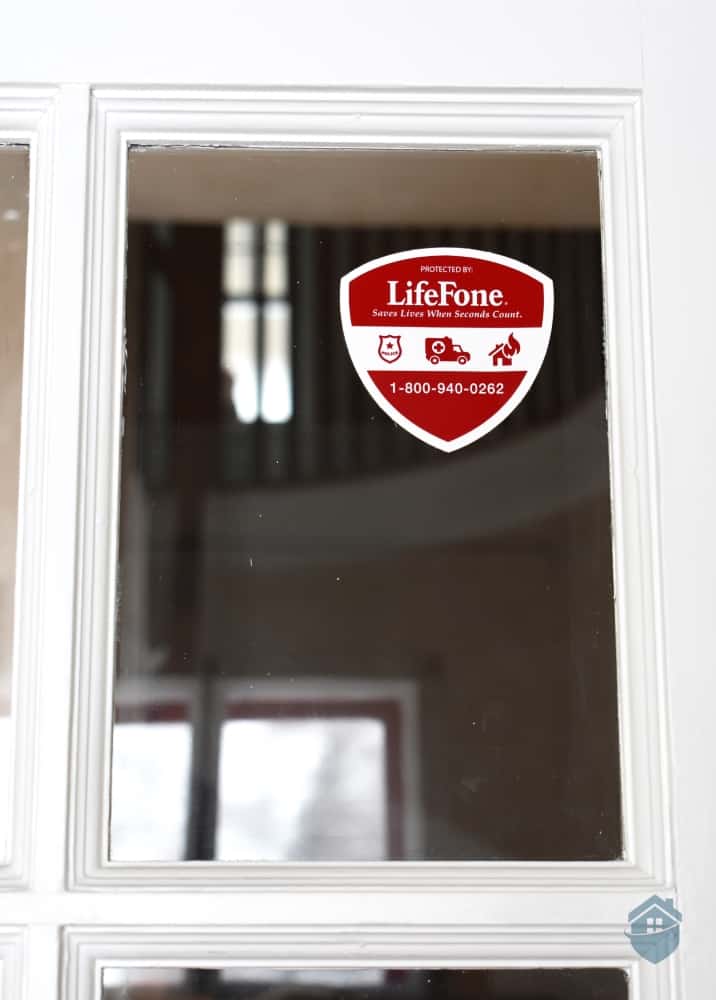
LifeFone Sticker
I rate LifeFone high in overall value. You can find less expensive at-home alert systems on the market, but they don’t offer the same breadth of features. In my experience, added services that benefit both the older adult and the caregiver are invaluable for many families. LifeFone offers medication reminders, activity assurance, and daily check-ins. In addition, you definitely won’t be skimping on quality; the range on LifeFone in-home systems is among the best in the business. Thirteen hundred feet is nearly three and a half football fields!
As for mobile emergency service, I think LifeFone’s $45.95 monthly price for their top-of-the-line GPS system is a decent value. Like the in-home systems, you can find other mobile systems that cost a few dollars less each month. But this little, lightweight, all-in-one device is worth its slightly greater cost.
And don’t forget to factor in all of LifeFone’s door-busting deals mentioned above and the fact that LifeFone doesn’t charge equipment or activation fees and only charges $5 for fall detection on most of its systems.
LifeFone medical alert systems may not be the best fit for penny pinchers, but they are among the best for those who appreciate quality and value.
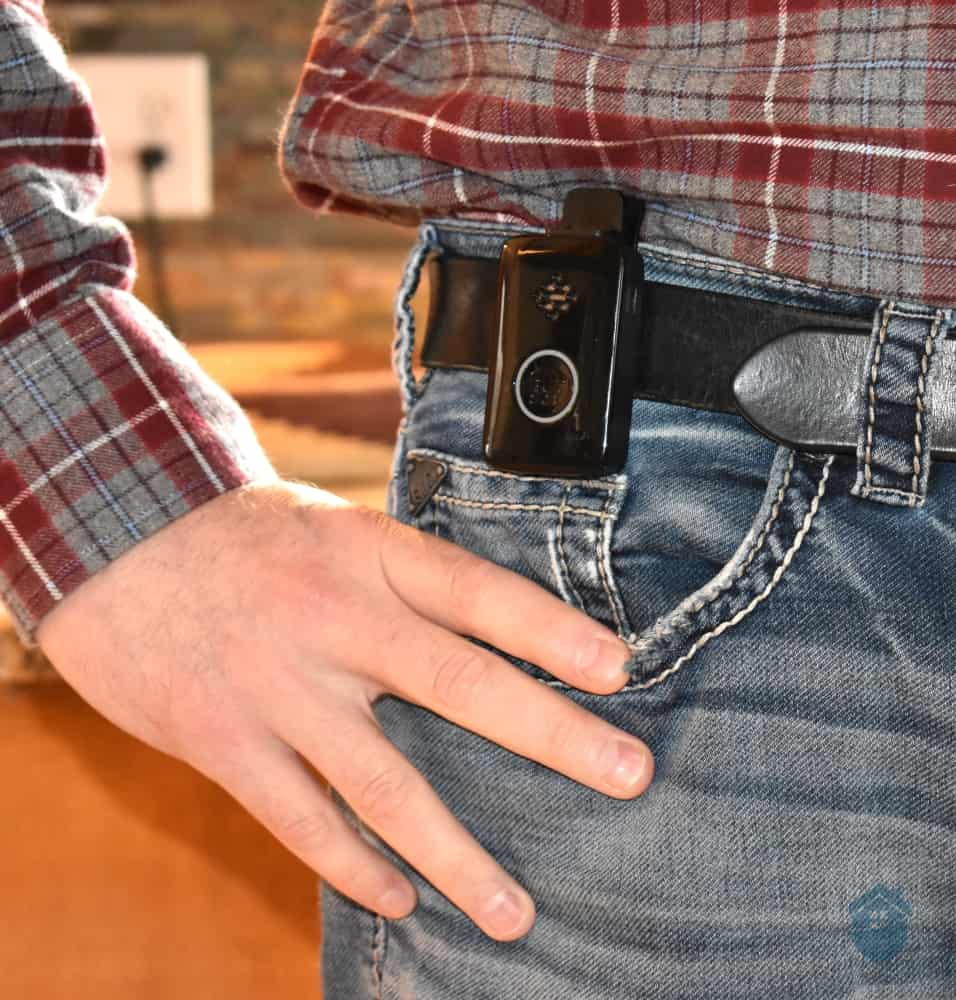
LifeFone on Belt
As mentioned, LifeFone has been in business since 1976. Initially, they provided medical alert buttons for healthcare facilities to monitor on their own. By the early 1980s, LifeFone established its own call center and began offering home medical alert systems. Today LifeFone fields landline and cellular alerts from its call center in White Plains, New York. They also have contracts with backup call centers in Syracuse, New York, and Corona, California.
Over the last four decades, the company has earned accolades and accreditations from respected consumer advocates such as WebMD, and many more. Overall, I think LifeFone’s package options and monthly monitoring plans are worth considering.
Yes. For example, if you request that a caregiver be called before Emergency Medical Services, LifeFone will happily comply.
LifeFone will assist in other types of situations such as a fire or home intrusion.
The Voice-In-Pendant is 2.6” x 1.57” x .67” and weighs 1.7 ounces.
The device can be used in the shower but it should not be submerged in water.
Good question. The Lifetime Subscriber Equipment Guarantee offers a free replacement of equipment for regular wear and tear. Some older adults, like the person with dementia who loses things frequently, may want to invest in the protection plan to cover the cost of equipment in case of loss, theft, or damage.
No, you will not need to sign a contract with LifeFone. You can cancel service at any time without penalty. You will be asked to sign a service agreement that states the terms of service and requests information such as your emergency contacts, etc.
Caregiving.org. (2020). Caregiving in the U.S. 2020.
https://www.caregiving.org/caregiving-in-the-us-2020/
AT&T. (Accessed May 2020). Wireless Coverage.
https://www.att.com/maps/wireless-coverage.html
Theconversation.com. (2019, March 14). Rise and fall of the landline: 143 years of telephones becoming more accessible – and smart.
https://theconversation.com/rise-and-fall-of-the-landline-143-years-of-telephones-becoming-more-accessible-and-smart-113295
TrustPilot. (Accessed May 2020.) LifeFone.com.
https://www.trustpilot.com/review/lifefone.com